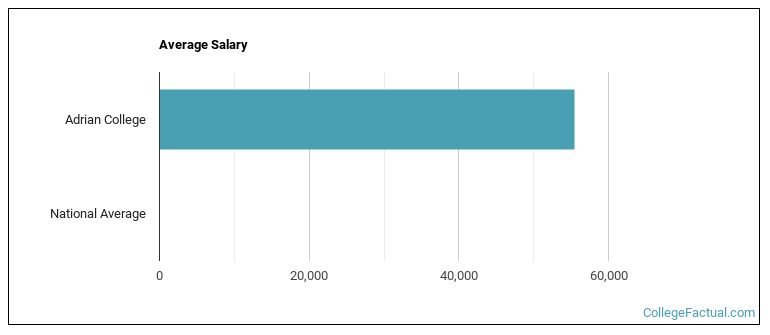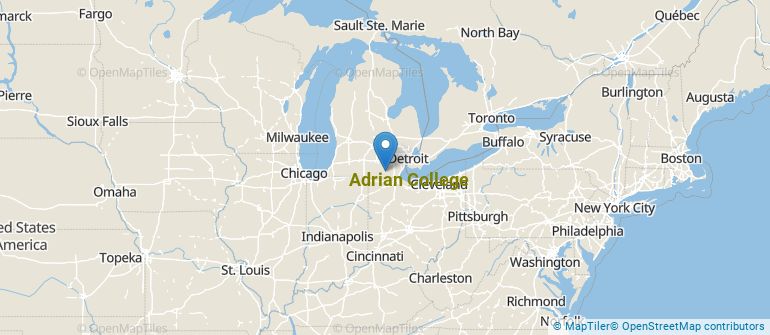 by our College Data Analytics Team
by our College Data Analytics TeamExplore the best ranked schools for the programs you are most interested in.
College Factual ranked Adrian as #1,070 out of 2,152 colleges and universities in the country on its 2025 Best Colleges list.
Adrian is also ranked #25 out of 56 schools in Michigan.
Adrian College has an acceptance rate of 69%, which means the school is serious about who it admits. Take your time in putting together a strong application that highlights why you are a good fit for Adrian.
About 93% of students accepted to Adrian submitted their SAT scores. When looking at the 25th through the 75th percentile, SAT Evidence-Based Reading and Writing scores ranged between 470 and 580. Math scores were between 470 and 580.
The student to faculty ratio at Adrian College is about average at 16 to 1. This ratio is often used to gauge how many students might be in an average class and how much time professors will have to spend with their students on an individual level. The national average for this metric is 15 to 1.
Another measure that is often used to estimate how much access students will have to their professors is how many faculty members are full-time. The idea here is that part-time faculty tend to spend less time on campus, so they may not be as available to students as full-timers.
The full-time faculty percentage at Adrian College is 45%. This is comparable to the national average of 47%.
The freshmen retention rate tells us what percentage of first-year, full-time students choose to continue on to their sophomore year at a particular school. The rate at Adrian College is 67%, which is about average when compared to the national rate of 68%.
The on-time graduation rate for someone pursuing a bachelor's degree is typically four years. This rate at Adrian for first-time, full-time students is 45%, which is better than the national average of 33.3%.
Find out more about the retention and graduation rates at Adrian College.
During the 2017-2018 academic year, there were 1,788 undergraduates at Adrian with 1,738 being full-time and 50 being part-time.
| $0-30 K | $30K-48K | $48-75 | $75-110K | $110K + |
|---|---|---|---|---|
| $18,619 | $20,384 | $21,237 | $25,896 | $28,434 |
The net price is calculated by adding tuition, room, board and other costs and subtracting financial aid.Note that the net price is typically less than the published for a school. For more information on the sticker price of Adrian, see our tuition and fees and room and board pages.
It's not uncommon for college students to take out loans to pay for school. In fact, almost 66% of students nationwide depend at least partially on loans. At Adrian, approximately 73% of students took out student loans averaging $6,908 a year. That adds up to $27,632 over four years for those students.

Get more details about the location of Adrian College.

Contact details for Adrian are given below.
| Contact Details | |
|---|---|
| Address: | 110 S Madison St, Adrian, MI 49221-2575 |
| Phone: | 517-265-5161 |
| Website: | www.adrian.edu/ |
| Most Popular Majors | Bachelor’s Degrees | Average Salary of Graduates |
|---|---|---|
| Health & Physical Education | 63 | $36,808 |
| Criminal Justice & Corrections | 40 | $34,112 |
| Business Administration & Management | 31 | $41,129 |
| General Biology | 29 | NA |
| Accounting | 26 | NA |
| Teacher Education Subject Specific | 26 | $42,118 |
| Marketing | 25 | $44,122 |
| Design & Applied Arts | 18 | NA |
| Allied Health Professions | 17 | NA |
| Health & Medical Administrative Services | 15 | NA |
Online learning is becoming popular at even the oldest colleges and universities in the United States. Not only are online classes great for returning adults with busy schedules, they are also frequented by a growing number of traditional students.
In 2022-2023, 391 students took at least one online class at Adrian College. This is an increase from the 244 students who took online classes the previous year.
| Year | Took at Least One Online Class | Took All Classes Online |
|---|---|---|
| 2022-2023 | 391 | 47 |
| 2021-2022 | 244 | 37 |
| 2020-2021 | 127 | 46 |
| 2018-2019 | 20 | 5 |
Footnotes
*The racial-ethnic minorities count is calculated by taking the total number of students and subtracting white students, international students, and students whose race/ethnicity was unknown. This number is then divided by the total number of students at the school to obtain the racial-ethnic minorities percentage.
References
More about our data sources and methodologies.